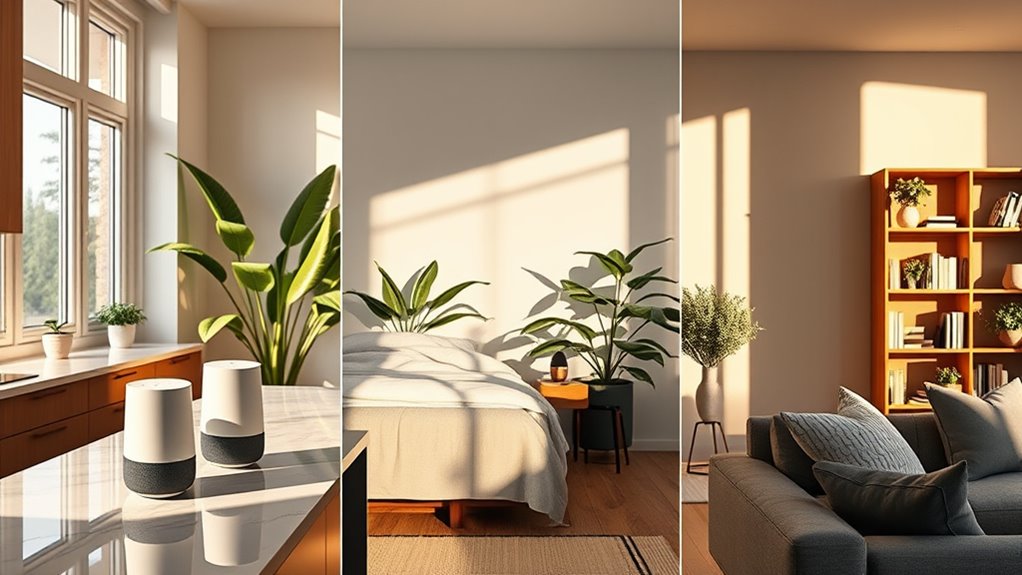To integrate voice assistants into every hotel room, start by choosing between devices like the Amazon Echo Dot or Google Home Mini, depending on your audio needs. Place them centrally in the room for ideal voice recognition. Customize commands for a seamless guest experience, allowing control over lighting and entertainment. Guarantee reliable internet connectivity and implement strong data protection measures. There’s more to take into account for keeping both guests and staff satisfied.
Key Takeaways
- Choose between Amazon Echo Dot and Google Home Mini based on audio capabilities and compatibility with existing systems for optimal integration.
- Ensure strategic placement of devices, like central locations or ceiling mounts, to enhance voice recognition and accessibility.
- Utilize custom commands to allow guests to control room features, enhancing their experience and streamlining staff tasks.
- Implement robust data protection measures, such as encryption and secure authentication, to safeguard guest information and privacy.
- Regularly update software and firmware to maintain security and functionality, ensuring a seamless voice assistant experience for guests.
Benefits of Integrating Voice Assistants in Hotel Rooms
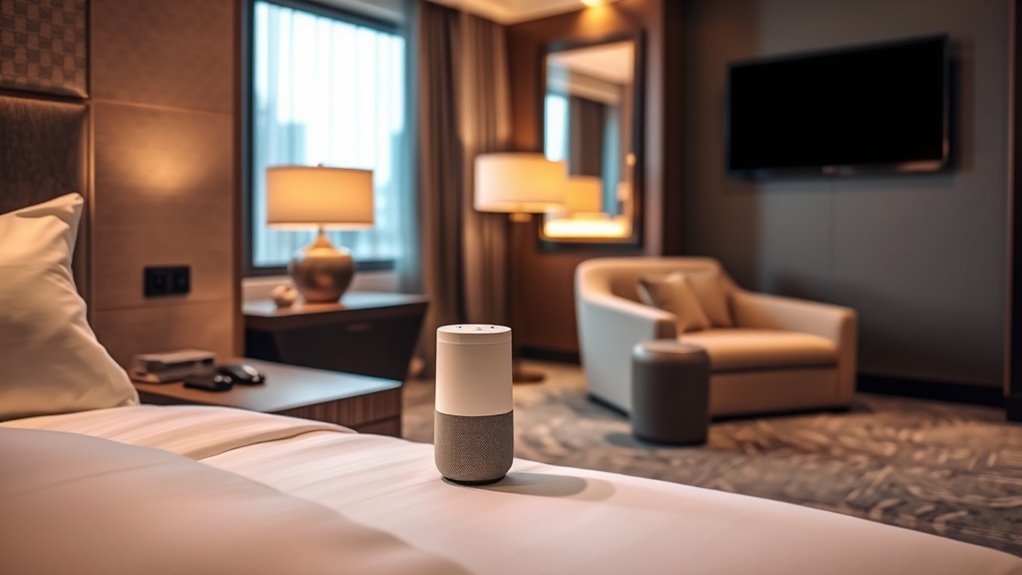
When you step into a hotel room equipped with a voice assistant, you instantly experience a new level of convenience and comfort.
With voice control, you can effortlessly manage smart devices like lighting and temperature, creating your ideal environment.
Need room service or a dinner reservation? Just ask, and watch how this technology streamlines your requests, enhancing guest satisfaction.
Hotels that adopt these systems not only elevate your experience but also boost operational efficiency by allowing staff to focus on personalized service.
This modern touch differentiates properties in a competitive market, appealing to tech-savvy travelers.
Ultimately, integrating voice assistants transforms your stay into a memorable, hassle-free experience that caters to your every need.
Choosing Between Amazon Echo Dot and Google Home Mini
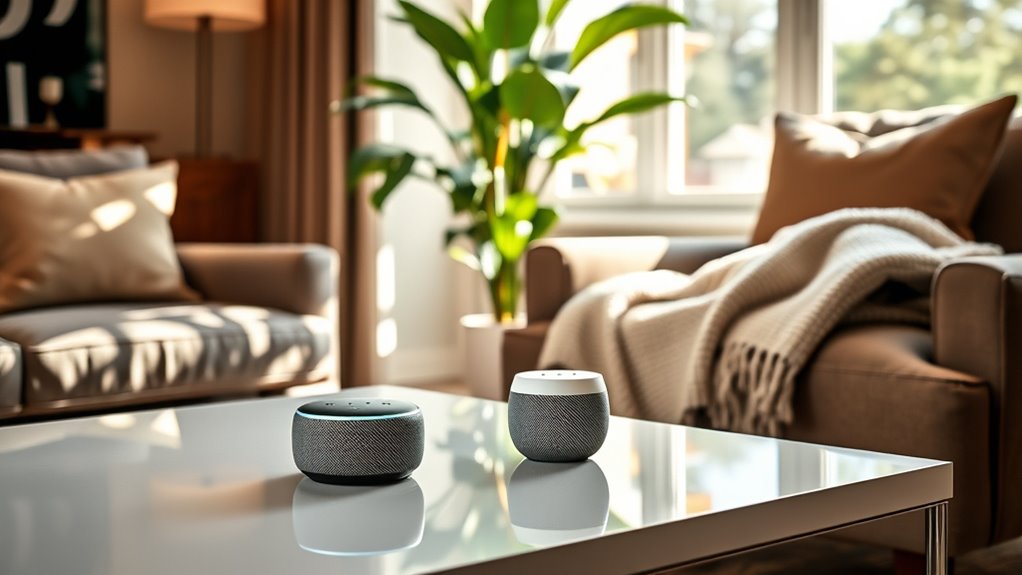
Which voice assistant fits your needs better, the Amazon Echo Dot or the Google Home Mini?
If you’re looking for seamless home automation, the Echo Dot stands out. It features a 3.5mm audio output, easily connecting to Whole House Audio systems, while the Google Home Mini relies on its built-in speaker.
The Echo Dot can also be mounted for ideal microphone access, unlike the Mini, which requires Bluetooth pairing and has a limited range.
The Echo Dot offers flexible mounting for optimal microphone access, while the Mini’s Bluetooth pairing limits its range.
Plus, only the Echo Dot allows you to hear Alexa’s responses through your WHA system, enhancing your audio experience.
If multi-room audio is a priority, the Echo Dot is clearly the more versatile choice, offering superior compatibility and sound quality over the Google Home Mini.
Optimal Placement for Voice Assistants
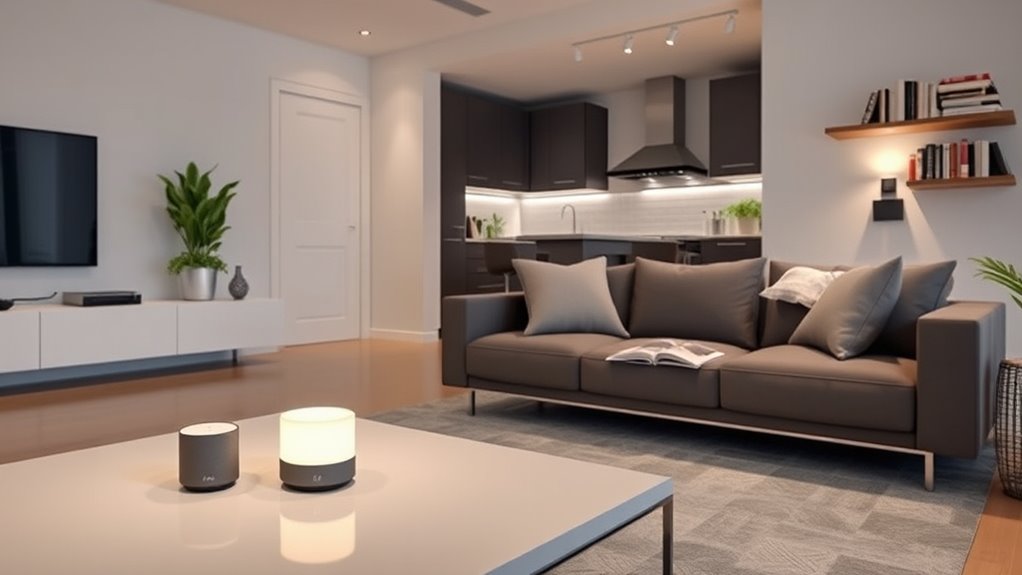
To guarantee your voice assistant delivers peak performance, consider placing it in a central location or mounting it on the ceiling. This ideal placement enhances voice recognition, allowing you to issue commands effectively across the room.
Here are some tips to guarantee the best setup:
- Use Cat 5e or Cat 6 cables for wired connections, especially for ceiling-mounted devices.
- For Amazon Echo Dot users, connect to Whole House Audio systems for better audio quality.
- Position Google Home Mini near a Bluetooth receiver to maintain functionality.
- Keep microphones away from speakers to improve wake word detection.
- Confirm all devices are elevated for maximum range and accessibility.
- Additionally, ensure optimal air quality by using an air purifier in the same room to minimize distractions from allergens and pollutants.
With these strategies, your smart home will work seamlessly!
Enhancing Guest Experience With Custom Commands
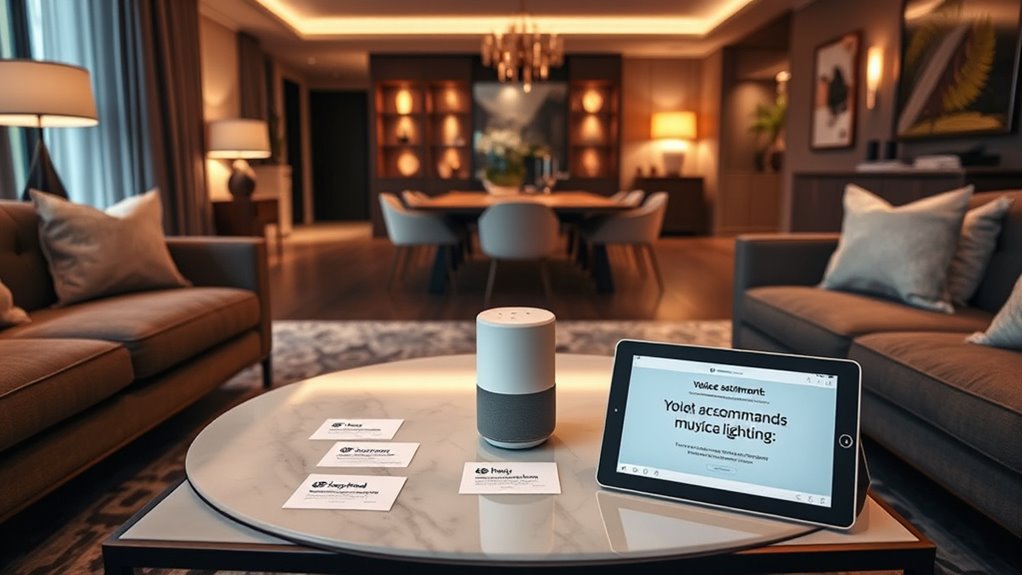
Integrating custom commands into voice assistants can greatly enhance your guests’ experience, allowing them to effortlessly control room features like lighting and temperature with just their voice.
When you set up smart assistants, guests can issue commands to adjust ambiance or entertainment systems, making their stay more comfortable. They can also make restaurant reservations, order room service, or request spa appointments, all through personalized voice commands, streamlining their experience.
This integration not only boosts guest satisfaction but also increases operational efficiency, letting your staff focus on personalized service rather than routine tasks.
Plus, enhanced privacy features, like disabling the microphone, guarantee guests feel secure while enjoying the convenience of voice-controlled services in their rooms.
Ensuring Reliable Internet Connectivity
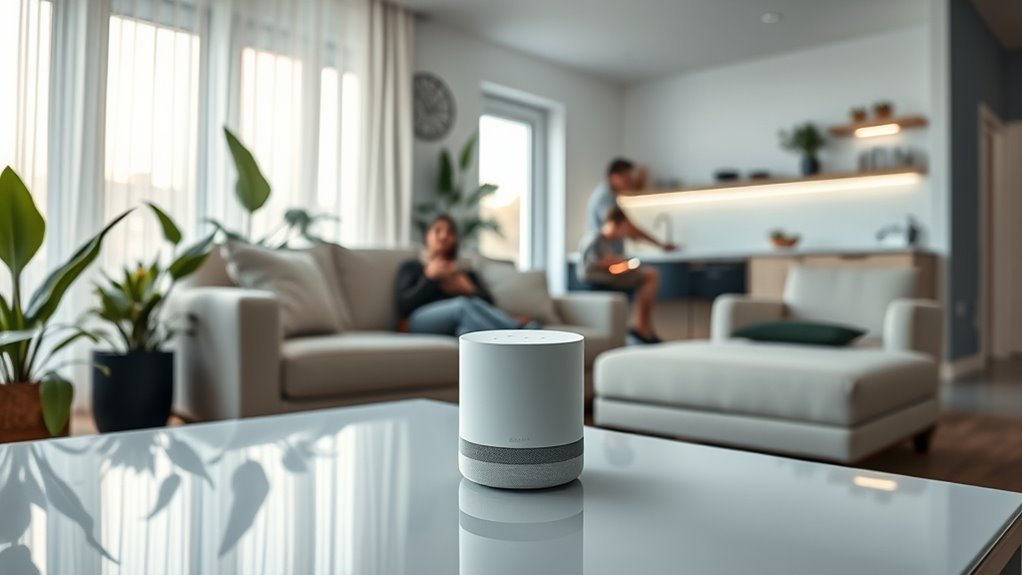
Since reliable internet connectivity is crucial for voice assistants to work effectively, guaranteeing a strong WiFi signal in every room is important.
By doing so, you can maintain control over your devices and enable seamless communication through voice commands. Here are a few tips to enhance your connectivity:
- Install a mesh network system to eliminate dead zones.
- Use a range extender for hard-to-reach areas.
- Guarantee at least 1 Mbps bandwidth per device; higher speeds are better.
- Regularly test your network to identify and fix connectivity issues.
- Consider using wired Ethernet connections for stationary voice assistants.
Data Protection and Privacy Measures

As you integrate voice assistants into your home, it’s essential to prioritize data protection and privacy.
Understanding encryption and security protocols, managing user consent, and utilizing data anonymization techniques can greatly enhance your peace of mind. Additionally, being aware of potential cybersecurity vulnerabilities can help you take proactive measures to secure your devices.
Encryption and Security Protocols
When it comes to voice assistants, ensuring the security of your data is essential. You can take several steps to protect your user data and maintain your privacy:
- Implement robust encryption protocols, like AES-256, to keep your voice data secure during transmission.
- Utilize secure authentication methods such as OAuth 2.0 to verify your identity and control various voice assistant features.
- Regularly update firmware and software to defend against vulnerabilities.
- Stay informed about data collection practices and manage your privacy settings effectively.
- Comply with data protection regulations like GDPR or CCPA, ensuring responsible handling of your information.
- Additionally, consider the impact of AI-driven personalization on how data is used by voice assistants, as it can enhance user experiences while raising privacy concerns.
User Consent Management
To maintain trust and guarantee compliance with data protection regulations, it’s essential for users to be informed about the data collected by voice assistants. This includes understanding what voice recordings and usage patterns are gathered.
Implementing user consent management through clear opt-in and opt-out options empowers you to control your data sharing preferences effectively. Voice assistants like Alexa for Hospitality emphasize privacy by deleting voice commands daily, reinforcing the importance of data management.
You should also have the option to manually disable your voice assistant, especially during sensitive moments or when you’re offline. Regularly sharing transparency about data handling practices helps build trust and addresses any privacy concerns you may have about your information. Additionally, understanding the role of user consent management can significantly enhance your data protection efforts.
Data Anonymization Techniques
How can data anonymization techniques enhance your privacy while using voice assistants? By implementing these methods, you can greatly improve user privacy.
Techniques like pseudonymization and data masking protect identifiable information while allowing data analysis. Here are some key benefits:
- Data Minimization: Only collect essential data to reduce exposure risk.
- Regular Audits: Identify and remove unnecessary data retention.
- Encryption Methods: Secure anonymized data both in transit and at rest.
- Compliance: Meet regulations like GDPR and CCPA to safeguard privacy.
- Enhanced Usability: Retain data usability without compromising security.
Frequently Asked Questions
How Do You Put Speakers in Every Room?
To put speakers in every room, start by selecting compact options like the Amazon Echo Dot or Google Home Mini.
You can connect the Echo Dot to a Whole House Audio system for better sound. For a seamless setup, consider using ceiling mounts with Cat 5e cables.
In larger spaces, adding multiple microphones improves voice recognition.
Make sure all devices are on the same secure Wi-Fi network for ideal performance across your home.
How to Set up Home Assistant Voice Control?
To set up voice control with Home Assistant, start by ensuring all your devices are on the same secure Wi-Fi network.
Download and configure the Home Assistant app to connect your smart home devices.
Use a central hub for managing voice recognition, and place dedicated microphone arrays in each room to improve wake word detection.
Don’t forget to regularly update your Home Assistant software for the latest features and compatibility with new devices.
What Role Do Voice Assistants Play in a Smart Home?
In a smart home setup, voice assistants serve as your savvy sidekick, simplifying tasks and streamlining daily operations.
They connect seamlessly with smart devices, letting you control lighting, temperature, and security with just your voice.
You can craft customized routines, enhancing convenience and boosting efficiency.
Plus, these clever companions help you monitor energy use, ensuring your home runs smoothly and sustainably.
Embrace their capabilities, and elevate your living experience effortlessly!
What Technology Is Primarily Used in Voice Assistants for Understanding and Responding to User Commands?
Voice assistants primarily use Natural Language Processing (NLP) to understand and respond to your commands. They analyze your speech patterns and context, allowing them to interpret your requests accurately.
Machine learning algorithms enhance their capabilities by learning from your interactions, making them more efficient over time. Additionally, speech recognition technology converts your spoken words into text, while multi-microphone arrays improve sound capture, ensuring they hear you clearly, even in noisy environments.
Conclusion
Incorporating voice assistants into every room seems like a luxury, but it’s really just a way to make your guests feel at home—because who wouldn’t want a digital friend that listens to their every request? With the right setup, you’re not just providing convenience; you’re creating an experience that’s almost too good to be true. Just remember, while your guests might love the idea of a helpful assistant, they probably won’t appreciate it reminding them of their check-out time!
